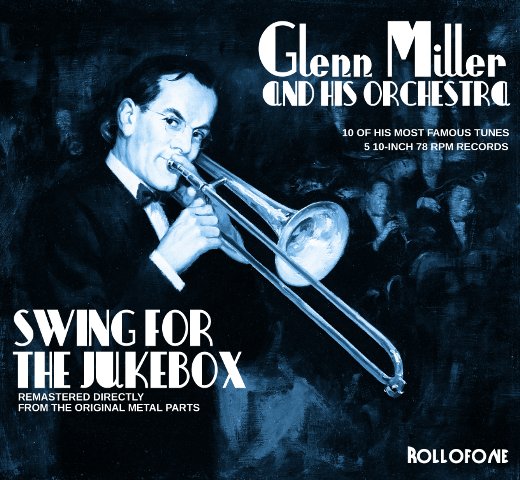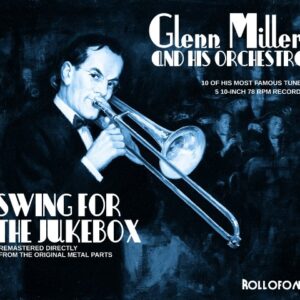Description
Set contains five 10″ vinyl 78rpm records with a total of ten re-mastered songs.
It took the better part of two months to re-master the original metal parts into this sound experience. As a matter of fact, a signed (repro) image of Glenn Miller was pinned on the wall above our studio speakers and – whenever we listened to a new version, we asked ourselves, if Glenn Miller would have liked it. Responsible audio engineers for this project: Michaela Merz and Mark Cederquist.
The records will be cut with a “micro groove” stylus. However: To accommodate standard groove pickups, we will cut the records a bit deeper which opens the groove at the top allowing the tracking with standard groove styli as well. The record set is not intended for mechanical or heavy pickups. Tested with Shure 78rpm Mono stylus and Astatic P-51-1 78rpm cartridge.



Dylan Utz –
Once upon a time, dance bands roamed from city to city playing music for the youth of America. Much like today, dance crazes swept the nation. Clubs, filled to the max, featured groups of musicians playing a variety of styles of Swing — a Pop-Jazz combination that was then the forefront of music. These were the wild and storied times of the Swing era.
By the late 1930s, Glenn Miller was well known among studio musicians as a decently skilled hot jazz trombonist and arranger. Wanting his own group after several attempts, he utilized an arrangement he wrote for Ray Noble’s American band years earlier. Believing his earlier bands had failed due to a lack of distinction, his new sound — a clarinet and tenor saxophone playing melody alongside three saxophones playing close harmony — broke through. Signing with Bluebird Records in late 1938, he made records like previously, to almost no avail. When the time came, the Glenn Miller and His Orchestra were unexpectedly booked to play the 1939 summer season at the Glen Island Casino, a good radio spot. It was here the band started to gain traction, and by the end of 1940 Miller proved that he wasn’t just on a hot streak. His group, with Joel Whitburn measuring seventeen number-one hits from 1939–43 (“That Old Black Magic” hit number one several months after their disbandment) quickly became one of the most popular chart acts of the 20th century.
Most know the rest of the story: “Moonlight Serenade”, “Little Brown Jug” (Despite the timeline of The Glenn Miller Story), wild success that warranted hiring several arrangers, Sun Valley Serenade, “Chattanooga Choo Choo” becoming the first ever Gold Record award, upgrading to Victor (35¢ to 50¢), Orchestra Wives, disbanding, Army Air Force band, rampant schedule, icon, tragic disappearance.
The United States and the World never forgot Glenn Miller’s sound. In the UK, a collection of Army Air Force cuts, “The Lost Recordings”, went Gold, selling over 100,000 copies in 1995 — more than a half-century after Miller’s untimely death. His three posthumous Billboard number-one albums (in 1945, 1947 and 1954), a feat accomplished by no other, exemplified his enduring popularity – proved time and again by reissues.
The biggest surprise came in 1954: “Limited Edition”, a box set meant only for collectors, sold around 120,000 impressions when RCA Victor expected four or five times less. George T. Simon, one time drummer for Miller and journalist responsible for many firsthand accounts of the Swing era, remarked that the set could’ve been produced with much more attention to detail, as it included incorrect dates and locations for the majority of the radio recordings, and liner notes penned by George Frazier, one of the harshest critics of Glenn Miller while he was still alive, who by the mid-fifties found himself in an executive position at RCA Victor. Read his piece unabashedly titled “Why I Hate Glenn Miller’s Music” from the March 1942 issue of Music and Rhythm magazine. The “Limited Edition” liner notes were well-written (“halcyon nights”) but one can only wonder as to the weight behind his words.
What Rollofone have done is honorable, bold and daring more than any major or minor record company with the metal masters or licensing to loan them out: re-releasing ten studio recordings on their original format, the ten-inch 78 rpm phonograph record.
The sound is very, very good and in the cases of some songs, like “American Patrol”, possibly the best available in any format. For this, Rollofone deserves much credit for, concerning the fact that they’re a small company with limited resources and their process, unlike the vast majority today, was entirely analogue. Dating from the early 2000s, Doug Pomeroy’s excellent remasters – Sony official – on compilation albums “Platinum Glenn Miller” and “Centennial Collection” have been the reference for most of the past two decades. The general consensus, at this time, is that they’re the clearest transfers, and a good measure for quality in the archival mastering field.
The sound here is indeed slightly noisier, perhaps owing to the analogue process — but take into account the engineers preserved the majority of the dynamic range of the original masters. This is detrimental to fidelity, alongside a few other qualities, in a very correlative relationship. An engineer working with these recordings must know how to deal with the many problems 78 rpm recordings present – crackle, pops and clicks, wow, rumble, swishing, speed differences, noise, and many other types of distortion that can vary case-by-case — all without harming the music and detail. Rollofone did a very good job of this.
These discs show quite well alongside an original pressing. Original pressings can be identified by the labels, Bluebird and Victor. First pressings of Glenn Miller were never on RCA Victor, a name change that happened between February and March 1946, with one exception: a live recording of “St. Louis Blues” issued by RCA Victor in Mexico. Except for Miller’s last few commercial 78s, original pressings don’t feature the RCA bubble at the bottom of a Victor label and new numbering system when the label ran out of their 27000 series. So, for instance, if you spot a Bluebird 78 with Glenn Miller and His Orchestra with an RCA bubble printed at the bottom of the label, that is, for sure, a reissue pressing. See “The Collector’s Guide to Victor Records” for additional information.
Although the equalization was perhaps not exact (you may have to adjust) the records pack very good punch alongside great high frequency response and sound slightly better on a microgroove stylus than at least the AT-MONO3/SP.
With those two CDs not in analogue format anywhere, and great condition 78s difficult to come by, this Rollofone release is the most accessible quality sounding Glenn Miller for your phonograph or jukebox, offering the best or very close to the best fidelity in the long and storied history of disc transfers.
Before, with a song like “Tuxedo Junction”, an original 78 would be preferable due to, sadly, the heavy damage of the metal parts. Rollofone’s perseverance shines through specifically on this track, in which they copied the higher frequencies from a commercial pressing and timed everything out in order to deliver a quality job, thus making owning an original 78 only optional. In the case of “American Patrol” the sound is better than ever. With “To You”, an alternate master was transferred, as it slightly differs from my original 78 pressing with “Stairway to the Stars” on its A-side. This set is much worth the value and I say this not as a jukebox owner, but as an aspiring transfer engineer.
The dedication, problem-solving and skillset displayed by the Rollofone team in this arduous process rival that of world class music corporations including Sony Legacy.
Buy yours quick — all those hepcats who are “sent” by the sweet sound of the most popular dance band of the Swing era are sure to slurp this release up.
Dale Dickerson (verified owner) –
After hearing the simple on the web site, I ordered the set. All I can say is WOW!!! I have all these songs on a cds and records. Before playing each side in this set, I listened to the best version in my collections. This set has best sound and has the most details preserved of any I own. This set brings out details lost in other releases. On my sound system, it out shines the Doug Pomeroy CDs.
I hope you order this set. If you do clear some floor space, adjust the lights and enter your own make believe ballroom for an evening dancing to Glenn Miller music as it should sound. Please excuse this short review. I need to rejoin my wife in the living room. You see Glenn Miller and his Orchestra are playing for our dance tonight and I do not want to keep her or them waiting…